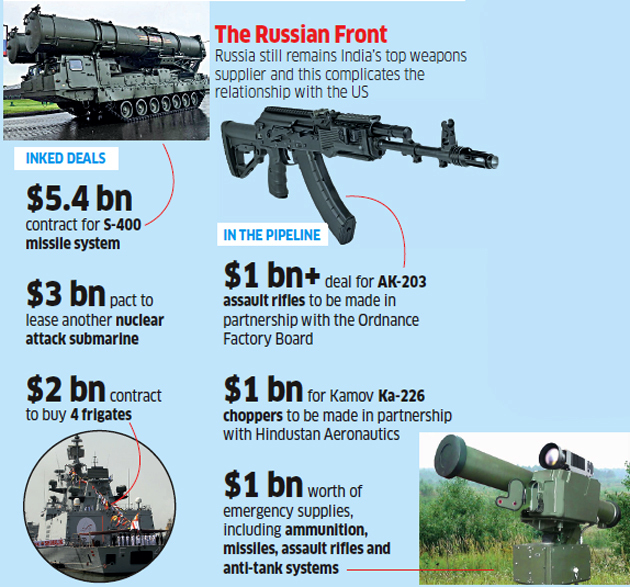International Relations
Indian Military Dependence on Russian Equipments
- 29 Oct 2021
- 5 min read
Why in News
According to the Military Balance 2021, India's present military arsenal is heavily stocked with Russian-made or Russian-designed equipment.
- The Military Balance is the International Institute for Strategic Studies’ (global think tank) annual assessment of the military capabilities and defence economics of 171 countries worldwide.
Key Points
- About the Report:
- There has been a considerable drop in India’s dependence on arms and equipment from Russia.
- However, the Indian military cannot operate effectively without Russian-supplied equipment and will continue to rely on its weapons systems in the near and middle terms.
- The report is crucial in the pretext of the US administration's review of Countering America’s Adversaries Through Sanctions Act (CAATSA).
- The CAATSA seeks to impose sanctions against the country buying military arms from Russia.
- India’s plan to purchase Russian-made S-400 air defense systems, which could trigger US sanctions under Section 231 of CAATSA.
- There has been a considerable drop in India’s dependence on arms and equipment from Russia.
- India-Russia’s Military Relations:
- Indian Dependence: According to Stockholm International Peace Research Institute (SIPRI), since 2010, Russia has been the source of nearly two-thirds (62%) of all Indian arms imports.
- Further, India has been the largest Russian arms importer, accounting for nearly one-third (32%) of all Russian arms exports.
- Favourable Russian Military Exports to India: Much of Russia’s influence in India comes through its willingness to provide weapons systems and technologies that no other country will export to India.
- The US only provides non-lethal defence technology like C-130j Super Hercules, C-13 Globemaster, P-8i Poseidon etc, while Russia provides high-end technology like Brahmos supersonic missile, S-400 anti-missile system.
- Russia also continues to offer advanced weapons platforms at relatively attractive rates.
- Army Cooperation: Around 10,000 pieces of military hardware are procured from Russia.
- The Indian Army’s main battle tank force is composed predominantly of Russian T-72M1 (66%) and T-90S (30%).
- India is negotiating on the price of AK103 rifles for Make in India.
- Naval Cooperation: Indian Navy’s sole operational aircraft carrier is a refurbished Soviet-era ship (INS Vikramaditya). The Navy’s fighter fleet comprises 43 MiG-29K.
- Four of the Navy’s 10 guided-missile destroyers are Russian Kashin class, and six of its 17 frigates are Russian Talwar class.
- The Navy’s sole nuclear-powered submarine is on lease from Russia, and eight of the service’s 14 other submarines are Russian-origin Kilo class.
- Air Force Cooperation: The Indian Air Force’s 667-plane FGA (Fighter Ground Attack) fleet is 71% Russian-origin (39% Su-30s (Sukhoi), 22% MiG-21s, 9% MiG-29s).
- All six of the service’s air tankers are Russian-made Il-78s.
- Missile Cooperation: The country’s only nuclear-capable supersonic cruise missile, BrahMos, is produced by a joint venture with Russia.
- The S-400 Air Defence Missile Systems is expected to be delivered by 2021.
- Military Exercises: India and Russia conduct the INDRA series of military exercises, which began in 2003. However, the first joint Tri-Services Exercise was conducted in 2017.
- Indian Dependence: According to Stockholm International Peace Research Institute (SIPRI), since 2010, Russia has been the source of nearly two-thirds (62%) of all Indian arms imports.
Way Forward
- Russia’s closeness with China and Pakistan has raised concerns for India. However, this closeness is tactical, mainly induced due to western sanctions, whereas Russia-India partnership is strategic.
- This is because Russia always saw India as a balancer against growing Chinese assertiveness.
- India can widen its procurement basket and can remain close to Russia for its strategic programmes and joint development of weapon systems.
- Thus, decoupling India’s choice of arms suppliers from the strategic relationship it has forged with the US is the way ahead.







